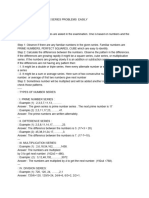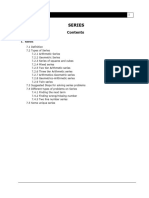Number Series Problem
Number Series Problem
Uploaded by
shajiahCopyright:
Available Formats
Number Series Problem
Number Series Problem
Uploaded by
shajiahOriginal Description:
Copyright
Available Formats
Share this document
Did you find this document useful?
Is this content inappropriate?
Copyright:
Available Formats
Number Series Problem
Number Series Problem
Uploaded by
shajiahCopyright:
Available Formats
How to solve number series problems easily By Tricks
Generally, two kinds of series are asked in the examination. One is based
on numbers and the other based on alphabets.
Step 1: Observer are there any familier numbers in the given series.
Familier numbers are primes numbers, perfect squares, cubes ... which are
easy to identify.
Step 2: Calculate the differences between the numbers. Observe the
pattern in the differences. If the differences are growing rapidly it might
be a square series, cube series, or multiplicative series. If the numbers
are growing slowly it is an addition or substration series.
If the differences are not having any pattern then
1. It might be a double or triple series. Here every alternate number or
every 3rd number form a series
2. It might be a sum or average series. Here sum of two consecutive
numbers gives 3rd number. or average of first two numbers give next
number
Step 3: Sometimes number will be multiplied and will be added another
number So we need to check those patterns
TYPES :
I. Prime number Series :
Example (1) : 2,3,5,7,11,13, ...........
Answer : The given series is prime number series . The next prime
number is 17.
Example (2) :2,5,11,17,23,...........41.
Answer: The prime numbers are written alternately.
II. Difference Series :
Example (1): 2,5,8,11,14,17,...........,23.
Answer: The difference between the numbers is 3. (17+3 = 20)
Example (2): 45,38,31,24,17,...........,3.
Answer: The difference between the numbers is 7. (177=10).III. Multiplication Series:
Example (1) : 2,6,18,54,162,.........,1458.
Answer: The numbers are multiplied by 3 to get next number. (162x3 =
486).
Example: (2) : 3,12,48,192,............,3072.
Answer : The numbers are multiplied by 4 to get the next number. (192x4
=768).
IV. Division Series:
Example (1): 720, 120, 24, .........,2,1
Answer: 720/6=120, 120/5=24, 24/4=6, 6/3=2, 2/2=1.
Example (2) : 32, 48, 72, 108, .........., 243.
Answer: 2. Number x 3/2= next number. 32x3/2=48, 48x3/2=72,
72x3/2=108, 108x3/2=162.
V. n2 Series:
Example(1) : 1, 4, 9, 16, 25, ......., 49
Answer: The series is 12, 22, 32, 42, 52, .... The next number is 62=36;
Example (2) : 0, 4, 16, 36, 64, ........ 144.
Answer :The series is 02, 22, 42, 62, etc. The next number is 102=100.
VI. n21 Series :
Example : 0, 3, 8, 15, 24,35, 48, ..........,
Answer : The series is 12-1, 22-1, 32-1 etc. The next number is 82-1=63.
Another logic : Difference between numbers is 3, 5, 7, 9, 11, 13 etc. The
next number is (48+15=63).
VII.n2+1 Series :
Example : 2, 5, 10, 17, 26, 37, .........., 65.
Answer : The series is 12+1, 22+1, 32+1 etc. The next number is
72+1=50.
IX. n3 Series :
Example : 1, 8, 27, 64, 125, 216, ......... .
Answer : The series is 13, 23, 33, etc. The missing number is 73=343.
X. n3+n Series :
Example : 2, 9, 28, 65, 126, 217, 344, ...........
Answer : The series is 13+1, 23+1, 33+1, etc. The missing number is
83+1=513.
XI. n31 Series :
Example : 0, 7, 26, 63, 124, ............, 342.
Answer: The series is 13-1, 23-1, 33-1 etc The missing number is 631=215.
XII. n3+n Series :
Example : 2, 10, 30, 68, 130, .............., 350.
Answer : The series is 13+1, 23+2, 33+3 etc The missing number is
63+6=222.
XIII. n3n Series :
Example :0, 6, 24, 60, 120, 210, ..............,
Answer : The series is 13-1, 23-2, 33-3, etc. The missing number is 737=336.
Another Logic : The series is 0x1x2, 1x2x3, 2x3x4, etc. The missing
number is 6x7x8=336.
XIV. n3+n2 Series :
Example : 2, 12, 36, 80, 150, ............,
Answer: The series is 13+12,23+22,33+32etc. The missing number is
63+62=252
XV. n3n2 Series:
Example: 0,4,18,48,100,.................,
Answer : The series is 13-12,23-22,33-32 etc. The missing number is 6362=180
XVI. xy, x+y Series:
Example: 48,12,76,13,54,9,32,...............,
Answer :2. 4+8=12, 7+6=13, 5+4=9 .: 3+2=5.
You might also like
- LET Reviewer - Arithmetic, Number Theory, Business MathDocument30 pagesLET Reviewer - Arithmetic, Number Theory, Business MathLyn Aldueza100% (4)
- Sequence & Series MCQsDocument11 pagesSequence & Series MCQsAdil Chaudhry100% (1)
- NOA History of USA-Complete NotesDocument192 pagesNOA History of USA-Complete NotesAyesha Naureen75% (16)
- PLSQL 4 3 Practice RodrigoDocument2 pagesPLSQL 4 3 Practice RodrigoRodrigoRojasHuertaNo ratings yet
- HomeopathyDocument18 pagesHomeopathysai prem0% (1)
- How To Solve Number Series Problems - Number Series and PatternDocument6 pagesHow To Solve Number Series Problems - Number Series and PatternClarisse SampangNo ratings yet
- How To Solve Number Series Problems Easily by TricksDocument50 pagesHow To Solve Number Series Problems Easily by TricksTapas BanerjeeNo ratings yet
- How To Solve Number Series Problems EasilyDocument3 pagesHow To Solve Number Series Problems Easilyianira267No ratings yet
- A9718052 - 21136 - 30 - 2019 - 1. UNIT - I Series CompletionDocument28 pagesA9718052 - 21136 - 30 - 2019 - 1. UNIT - I Series CompletionJatin ChaudharyNo ratings yet
- SeriesDocument53 pagesSeriesSandeep Varma's88% (8)
- 22.number Series Test GNDocument8 pages22.number Series Test GNChaya DeepikaNo ratings yet
- 1common Number PatternsDocument2 pages1common Number PatternsJoseph TingNo ratings yet
- 1 Sequence and Series Completion..Document52 pages1 Sequence and Series Completion..rishu kumarNo ratings yet
- VMC Verbal Reasoning Class 8 ModuleDocument36 pagesVMC Verbal Reasoning Class 8 ModuleAbhideep JainNo ratings yet
- 1 Number SeriesDocument16 pages1 Number Seriesthinkiit80% (5)
- Common Number PatternsDocument3 pagesCommon Number Patternsthornapple25No ratings yet
- ReasoningDocument79 pagesReasoningRamesh Valasa100% (1)
- 7th - Complete BookDocument65 pages7th - Complete BookKrishivraoNo ratings yet
- Odd Man Out and SeriesDocument4 pagesOdd Man Out and SeriesTAภaу ЎALLaмᎥlliNo ratings yet
- MCFKTP G3 S2 SC Number Pattern PuzzlesDocument5 pagesMCFKTP G3 S2 SC Number Pattern PuzzlesEric GoNo ratings yet
- Number PatternDocument13 pagesNumber PatternmisfloNo ratings yet
- Series Completion TestDocument35 pagesSeries Completion TestShivam GoyalNo ratings yet
- QUANTITATIVE APTITUDE SERIES (WWW - Freeupscmaterials.wordpress - Com)Document52 pagesQUANTITATIVE APTITUDE SERIES (WWW - Freeupscmaterials.wordpress - Com)k.palrajNo ratings yet
- GR 3 Math Chapter 6Document18 pagesGR 3 Math Chapter 6Kheyiru RediNo ratings yet
- Number Series and PatternsDocument4 pagesNumber Series and PatternsDianne De Guzman100% (1)
- MAbility - 1 - Series - 8th - WADocument12 pagesMAbility - 1 - Series - 8th - WAKrishivraoNo ratings yet
- ReasoningLecture1W 12Document15 pagesReasoningLecture1W 12tamilanbaNo ratings yet
- Number PatternDocument14 pagesNumber PatternSolehah Roslan100% (1)
- Arithmetic Sequences: ExampleDocument3 pagesArithmetic Sequences: ExampleNajwa SuhaimiNo ratings yet
- Finding The Terms of A Sequence: After Going Through This Module, You Are Expected ToDocument26 pagesFinding The Terms of A Sequence: After Going Through This Module, You Are Expected ToEdmark DagumanpanNo ratings yet
- Year 8 Mathematics WorkbookDocument18 pagesYear 8 Mathematics WorkbookzeyiNo ratings yet
- Odd Numbers and SeriesDocument9 pagesOdd Numbers and SeriesOmer Ali100% (1)
- CSC Number SeriesDocument3 pagesCSC Number SeriesRaquel disomimbaNo ratings yet
- 03 - SequencesDocument20 pages03 - SequencesSora KageNo ratings yet
- Ver 1Document6 pagesVer 1Vikram SinghNo ratings yet
- 1) Number Series Shortcut Tricks & TipsDocument24 pages1) Number Series Shortcut Tricks & Tipsankitkumarthakur12No ratings yet
- STD XTH Algebra Maharashtra BoardDocument34 pagesSTD XTH Algebra Maharashtra BoardSingh Sudip100% (1)
- Number Series ConceptDocument5 pagesNumber Series ConceptkavinkumareceNo ratings yet
- Lesson 2 Illustrating Arithmetic SequenceDocument34 pagesLesson 2 Illustrating Arithmetic Sequencehandball ajmpNo ratings yet
- Ntse Series Completion TheoryDocument22 pagesNtse Series Completion TheoryRitu Agrawal100% (1)
- 6 Sequence & Series Part 1 of 2 PDFDocument20 pages6 Sequence & Series Part 1 of 2 PDFswathiyallapragadaNo ratings yet
- Aptitude PDFDocument183 pagesAptitude PDFmounica monaNo ratings yet
- MODULE3 GE003 Math in The Modern WorldDocument7 pagesMODULE3 GE003 Math in The Modern WorldLady ReoladaNo ratings yet
- Ap and GPDocument66 pagesAp and GPDiøgo JønaNo ratings yet
- 40 MATHS TRICK (For More Book - WWW - Gktrickhindi.com) PDFDocument36 pages40 MATHS TRICK (For More Book - WWW - Gktrickhindi.com) PDFratnaNo ratings yet
- Ainun Putri Nurdiya - 2C - EST - Tugas Pertemuan Ke 3Document5 pagesAinun Putri Nurdiya - 2C - EST - Tugas Pertemuan Ke 3Ryan FadillahNo ratings yet
- Computer Aided Instructional MaterialDocument80 pagesComputer Aided Instructional MaterialEmill Rivera AsuncionNo ratings yet
- Alphabet SERIES IN LOGICAL REASONINGMATERIAL - PDF - 20240823 - 195007 - 0000Document13 pagesAlphabet SERIES IN LOGICAL REASONINGMATERIAL - PDF - 20240823 - 195007 - 0000favourakonu76No ratings yet
- 40 MATHS TRICK (For More Book - WWW - Gktrickhindi.com) PDFDocument36 pages40 MATHS TRICK (For More Book - WWW - Gktrickhindi.com) PDFAzeem ChaudharyNo ratings yet
- Mathematics 3 Quarter 2 Module 8 Multiples of 1 To 2 Digit Numbers 1Document10 pagesMathematics 3 Quarter 2 Module 8 Multiples of 1 To 2 Digit Numbers 1Nariza BasilioNo ratings yet
- Important Concept and Tricks On Series: WWW - Careerpower.inDocument2 pagesImportant Concept and Tricks On Series: WWW - Careerpower.inSAATWADUMADHUNo ratings yet
- SequencesDocument20 pagesSequencesChristine Joy ErosidoNo ratings yet
- Number SeriesDocument5 pagesNumber SeriesDivya PriyaNo ratings yet
- G10. Lesson PlanDocument3 pagesG10. Lesson PlanMaria Martina Delos Santos100% (1)
- LAS WEEK 2A-The NTH Term of A SequenceDocument2 pagesLAS WEEK 2A-The NTH Term of A SequenceZyra Catherine MoralesNo ratings yet
- MODULE 1 - Mathematics in NatureDocument23 pagesMODULE 1 - Mathematics in NatureALMIRA LOUISE PALOMARIANo ratings yet
- INDICESDocument10 pagesINDICESVer Terese RichardNo ratings yet
- 101 Shortcuts in MATHDocument20 pages101 Shortcuts in MATHTanusri Ghosh100% (1)
- Odd Man Out and Series PDFDocument2 pagesOdd Man Out and Series PDFSubhash HandaNo ratings yet
- Odd Man Out and SeriesDocument2 pagesOdd Man Out and SeriesSubhash HandaNo ratings yet
- LM Pre Calculus Q1 W7 9 MELC 1 2 Module 8Document17 pagesLM Pre Calculus Q1 W7 9 MELC 1 2 Module 8Armaine Shazel SantosNo ratings yet
- Master Fundamental Concepts of Math Olympiad: Maths, #1From EverandMaster Fundamental Concepts of Math Olympiad: Maths, #1No ratings yet
- Pakistan-China Economic CorridorDocument28 pagesPakistan-China Economic Corridorshajiah100% (1)
- Modern Feminism in The USADocument11 pagesModern Feminism in The USAshajiahNo ratings yet
- Project Quality ManagementDocument25 pagesProject Quality ManagementshajiahNo ratings yet
- Governance and Administrative Reforms.Document37 pagesGovernance and Administrative Reforms.shajiah75% (4)
- Project Risk Management: Compiled by Muhammad Aleem Habib June 25, 2013 Information Derived From PMBOK & Rita MulcahyDocument115 pagesProject Risk Management: Compiled by Muhammad Aleem Habib June 25, 2013 Information Derived From PMBOK & Rita MulcahyshajiahNo ratings yet
- Karl Marx-Division of LaborDocument33 pagesKarl Marx-Division of LaborshajiahNo ratings yet
- SuicideDocument15 pagesSuicideshajiahNo ratings yet
- Basic (Micro and Macro, Development) Economic ConceptsDocument163 pagesBasic (Micro and Macro, Development) Economic ConceptsshajiahNo ratings yet
- Impact of Social MediaDocument8 pagesImpact of Social MediashajiahNo ratings yet
- Quaid QuotesDocument9 pagesQuaid QuotesshajiahNo ratings yet
- Assignment - 1Document73 pagesAssignment - 1shajiahNo ratings yet
- Quotes of M. Ali JinnahDocument2 pagesQuotes of M. Ali JinnahshajiahNo ratings yet
- The Settlement of International DisputesDocument28 pagesThe Settlement of International Disputesshajiah0% (1)
- PK Textile IndustryDocument42 pagesPK Textile IndustryshajiahNo ratings yet
- My Vision Board 2011-2015Document19 pagesMy Vision Board 2011-2015shajiahNo ratings yet
- Case Study - Ducor ChemicalDocument4 pagesCase Study - Ducor ChemicalshajiahNo ratings yet
- Kenya Political SystemDocument15 pagesKenya Political SystemshajiahNo ratings yet
- EDUCATION System in PakistanDocument46 pagesEDUCATION System in PakistanshajiahNo ratings yet
- MadVR - Crash ReportDocument34 pagesMadVR - Crash ReportberstuckNo ratings yet
- Inverse Matrix of 2x2, 3x3, 4x4Document19 pagesInverse Matrix of 2x2, 3x3, 4x4Bobby Rizky ShaputraNo ratings yet
- Ettercap PDFDocument13 pagesEttercap PDFhardoiseNo ratings yet
- GenepopDocument51 pagesGenepoppraveenraj90No ratings yet
- Erlang: The Unintentional Neural Network Programming LanguageDocument56 pagesErlang: The Unintentional Neural Network Programming Languagekoteko87No ratings yet
- TUVFSDocument3 pagesTUVFSspkaliNo ratings yet
- CV Daniela StoicaDocument6 pagesCV Daniela Stoicadani_stoiNo ratings yet
- The Role of Pinyin For Chinese NetizensDocument9 pagesThe Role of Pinyin For Chinese NetizensKelvin PárragaNo ratings yet
- Easy2Grocery: Cloud Strategy in A Tier-II CityDocument13 pagesEasy2Grocery: Cloud Strategy in A Tier-II CityAkshay SinghNo ratings yet
- Salient Features of Ra 11032: "Responsibilities of Lgus and Ngas"Document29 pagesSalient Features of Ra 11032: "Responsibilities of Lgus and Ngas"Mike MikeNo ratings yet
- PraveenMadupu SQLDBA 9+yearsDocument3 pagesPraveenMadupu SQLDBA 9+yearsPraveen MadupuNo ratings yet
- LFD259 Labs - V2019 01 14Document86 pagesLFD259 Labs - V2019 01 14Bill Ho100% (2)
- Theories and Applications of Plate Analysis 0471429899Document4 pagesTheories and Applications of Plate Analysis 0471429899Pandal RajNo ratings yet
- Web Application Web FormsDocument66 pagesWeb Application Web FormsManoj Manu100% (1)
- Lakshpreet SinghDocument13 pagesLakshpreet SinghARNAVNo ratings yet
- NotebookDocument282 pagesNotebookbabjeereddyNo ratings yet
- 1 PHP Iq1Document71 pages1 PHP Iq1Nandha Kumar. KNo ratings yet
- Scms School of Technology and ManagementDocument4 pagesScms School of Technology and Managementrahulrnair4u_5534754No ratings yet
- 6 Modal Frequency Response AnalysisDocument26 pages6 Modal Frequency Response Analysisvijaykumarb1987No ratings yet
- Project Proposal Template 19Document6 pagesProject Proposal Template 19Siddanth DeswalNo ratings yet
- Integral HogDocument14 pagesIntegral HogWayne WebbNo ratings yet
- Resume Denis Parra-SantanderDocument3 pagesResume Denis Parra-SantanderDenis Parra SantanderNo ratings yet
- Skrill Quick Checkout Guide v7.10Document118 pagesSkrill Quick Checkout Guide v7.10IbrarAsadNo ratings yet
- Optipoint Instruction Card Hipath 4000: Standard and AdvanceDocument2 pagesOptipoint Instruction Card Hipath 4000: Standard and Advanceacs_spNo ratings yet
- Process Flow Diagram FormatDocument1 pageProcess Flow Diagram FormatScribdTranslationsNo ratings yet
- OoadDocument2 pagesOoadBrian KanyuaNo ratings yet
- Smart Card 01Document67 pagesSmart Card 01ayanthak100% (1)
- SQL Having ClauseDocument6 pagesSQL Having ClauseGood ManNo ratings yet












































































































